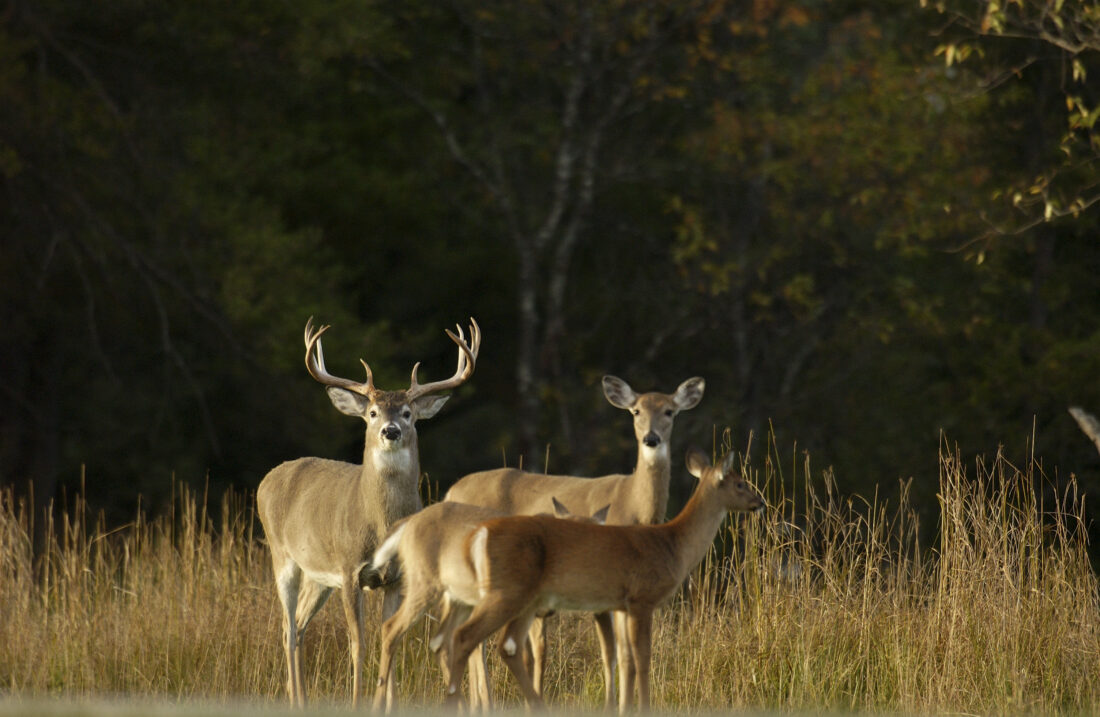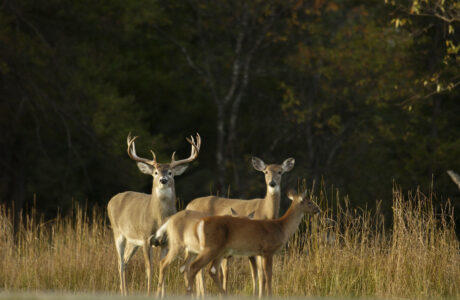Firearm deer hunting season begins today

Courtesy Photo by the Michigan Department of Natural Resources (DNR) Whitetail deer are seen standing in a field.
The Department of Natural Resources (DNR) reminds Michigan residents that the Michigan 2025 firearm deer hunting season begins today and runs through Sunday, Nov. 30. Hunting will be open statewide on public and private lands.
According to the DNR, last year, hunters harvested nearly 180,000 deer during the two-week regular firearm season, which was about half of the total deer harvest from all seasons combined. Additional upcoming harvest periods include late segment archery (Dec. 1 to Jan. 1), muzzleloader season (Dec. 5 to 14), late antlerless firearm (Dec. 1 to Jan. 1), and others.
Deer season forecast
The DNR predicts that this year could bring a strong deer hunting season, mirroring a robust 2024, although hunters will encounter varying conditions across the state. Hunters in the northern Lower Peninsula, for example, should be aware of the lingering effects of the March 2025 ice storm that downed trees and limbs across 13 counties.
Report your deer harvest online
Online harvest reporting is required for all hunters who successfully take a deer, according to the DNR. Hunters can report their deer through the DNR Hunt Fish app or at Michigan.gov/DNRHarvestReport.
“Reporting your harvest gives us a real-time snapshot of how the season is going,” the DNR states.
2025 Deer Hunting Regulations Summary out now
The 2025 DNR’s Deer Hunting Regulations Summary contains up-to-date information on deer hunting regulations across the state, including season dates, license types and fees, baiting rules, bag limits, deer management unit boundaries, and more.
For on-demand access to this info that travels where hunters do, without the need for internet access, download the Michigan DNR Hunt Fish app.
Planning for EHD
According to the DNR, in 2025, epizootic hemorrhagic disease has been confirmed in wild deer in at least 16 counties in southern Michigan, which include Berrien, Calhoun, Cass, Clinton, Eaton, Gratiot, Hillsdale, Ingham, Ionia, Jackson, Lenawee, Livingston, Mecosta, Saginaw, Van Buren, and Washtenaw.
The DNR states that confirmation of EHD mortalities were announced in early September, and frost and snow in early November killed the adult midges that transmit the EHD virus by biting deer.
Though EHD can cause high deer mortality, the impact tends to be localized, with some areas seeing heavy losses while nearby areas show no effects, according to the DNR. There is no evidence humans can contract the EDH virus.
The DNR states that most hunters won’t need to change their harvest plans and should still target antlerless deer. However, some hunters in areas that were highly affected by EHD may consider modifying their harvest plans to reduce hunting pressure while the deer population recovers. After a widespread EHD outbreak in 2012, local herds showed signs of rebounding after just a couple of years and were fully recovered after four to five years.
Safety is key to a successful hunt
With Michigan’s firearm deer season starting today, the DNR reminds hunters to put safety first. All firearm deer hunters should practice the following habits:
– Treat every firearm as if it is loaded.
– Be aware of your surroundings – know your target and what is beyond it.
– Unload firearms when crossing obstacles and/or getting in or out of an elevated stand.
– Obey “no trespassing” signs; they are there for a reason.
– Obtain landowner permission to retrieve game that has wandered onto private property.
– Wear “hunter orange.” This is mandatory, according to the DNR, and increases visibility to other hunters. Hunter orange garments must be worn as the outer layer of clothing (such as caps, hats, vests, or jackets) and must be visible from all directions.
– During the firearm deer season, all hunters and nonhunters are encouraged to wear bright colors, especially hunter orange, when recreating near woods or fields where hunting may occur.
Chronic wasting disease (CWD)
The DNR is requesting hunter assistance with their efforts to monitor chronic wasting disease this year.
According to the DNR, CWD is a contagious illness that affects the nervous system of deer and elk. This year, the DNR is conducting focused testing for CWD in 11 counties in the Upper Peninsula and northern Lower Peninsula which include Baraga, Chippewa, Dickinson, Houghton, Iosco, Keweenaw, Luce, Mackinac, Ogemaw, Ontonagon, and Schoolcraft.
CWD testing is free for deer harvested in these counties when submitted through DNR drop boxes and staffed sample submission sites, according to the DNR. If hunters would like to keep antlers, they should remove them from the head. All heads tested for CWD are also screened for bovine tuberculosis. Results are posted to the DNR lab results webpage.
The DNR states that hunters in all other counties are eligible for free CWD testing by using a free lymph node kit that includes overnight shipping. Hunters must extract lymph nodes to submit to Michigan State University Veterinary Diagnostic Laboratory. Results from deer submitted to MSU will be sent directly to the hunter and will not appear on the DNR lab results webpage. Kits can be picked up from the locations listed on the CWD testing page. Hunters should call the office prior to arriving to ensure someone will be available to assist.
Bovine tuberculosis
Bovine tuberculosis is a highly infectious disease that can infect all mammals, including humans, according to the DNR. It’s transmitted either directly (contact between infected and noninfected animals) or indirectly (contaminated feed and water). Hunters should take caution when field dressing deer since humans can become infected with bovine tuberculosis.
This year, the DNR is conducting focused bovine tuberculosis monitoring in 11 counties in the northern Lower Peninsula which include Alcona, Alpena, Cheboygan, Crawford, Iosco, Montmorency, Ogemaw, Oscoda, Otsego, Presque Isle, and Roscommon.
To submit a deer for TB testing, hunters should take it to a DNR staffed deer check station, drop box or cooperating processor or taxidermist.
Help control the deer population — harvest a doe
In many areas in Michigan’s Lower Peninsula, there are more deer than the habitat can support. According to the DNR, this overpopulation can cause problems for people, such as more vehicle collisions, damage to crops and gardens, and the spread of wildlife diseases.
The DNR states that hunting regulations are in place to encourage hunters to harvest more antlerless deer.
“Hunters play a critical role in helping to manage deer numbers, which is important to protect public safety, reduce property damage, and limit disease spread,” the DNR states.


